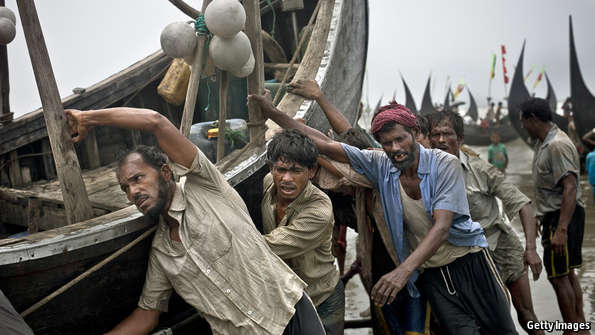Oppressed in Myanmar, Muslim Rohingyas are unwelcome in Bangladesh, too
THE watchtowers and the high-security fence on the border between Myanmar and Bangladesh make this frontier look impregnable. Yet thousands of Rohingyas cross into Bangladesh each year. Rohingyas are a Muslim group whose persecution in their mainly Buddhist home state of Rakhine in Myanmar is long-standing but has recently escalated. The Myanmar government does not recognise Rohingyas, many of whose ancestors originally hailed from Bengal during British colonial days, as one of the country’s many official ethnic minorities. Denied nationality since 1982, they are in effect stateless.
In Myanmar the Rohingyas are dismissed as foreign Bengalis. But they are not welcome in Bangladesh either. Some 500,000 Rohingyas were already living in Bangladesh before this latest wave of refugees. Many had come in previous surges in the 1970s and 1990s, when Myanmar’s military junta encouraged their flight.
Last year the Bangladeshi prime minister, Sheikh Hasina, ordered officials to resettle the 30,000-odd refugees living in camps near Cox’s Bazar, a tourist spot with the world’s longest unbroken beach. The chosen location is a barren island in the Bay of Bengal, called Thengar Char. It was formed about a decade ago by the sediments of the Meghna river, the confluence of the Ganges and the Brahmaputra rivers. The island is exposed and prone to flooding during spring tides. It does not appear on most maps.
“It is prime minister Sheikh Hasina’s desire that we rehabilitate the Rohingya people,” says Mohammad Nazrul Huda, the local police chief of Hatiya, the nearest inhabited spot to Thengar Char. The town lies about 90 minutes away by speedboat. Mr Huda places a map on his desk and draws a circle representing Thengar Char. It is, he says, a “very excellent” site for the Rohingyas, and he has recommended it to bureaucrats up at the home ministry in Dhaka, the capital.
The chairman of the local upazila, or district council, Abu Hasnat Moyeenuddin, produces a letter from the central government about the Rohingyas. One stipulation is that a new location for them must “minimise conflicts between Bangladeshis and Rohingyas”. What were the selection criteria? Distance from the mainland was very important, says Mr Moyeenuddin.
News of the planned relocation has spread fast. Mohammad Ishtaq, a labourer in Hatiya, says the Rohingyas are welcome to settle on Thengar Char, so long as they do not cause any disturbances. Others worry that they might worsen the problem of piracy in nearby waters.
The Rohingyas themselves view the proposed relocation to Thengar Char with deep suspicion. There is little information about how they would be housed, or who would pay. Stina Ljungdell, the representative in Dhaka of the UN’s refugee agency, says the government has not officially informed her agency of its plans. Yet the relocation is consistent with Bangladesh’s long-standing policy of making itself as unappealing as possible as a destination for Rohingyas.
Source: The Economist









